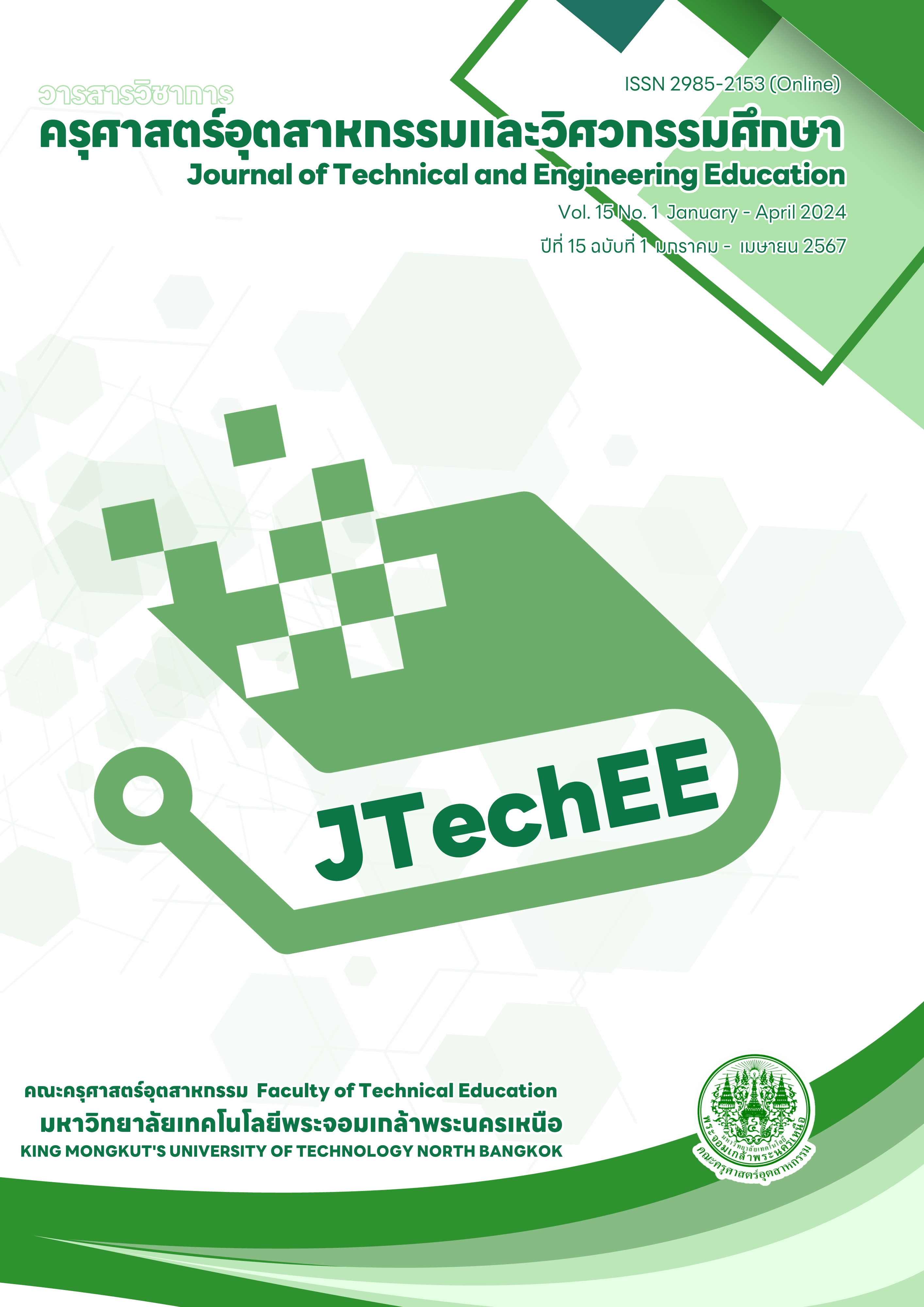Application of QR Codes to store equipment information to provide results-oriented education learning
Main Article Content
Abstract
This research aims to: 1. develop a system for collecting information on durable articles using QR codes, 2. evaluate the usability efficiency of the commodity storage system with a QR code, and 3. find the satisfaction of users of the commodity storage system with a QR code. The population and samples in this research were divided into two groups within the College of Industrial Technology at King Mongkut's University of Technology North Bangkok. The first group is made up of information technology experts. They were selected by a specific method of three people to evaluate the developed system. The second group is system users, which consist of department staff, materials scholars, and lecturers. The system users will be selected by a specific method of 30 people to try out and find satisfaction after using the system. The tool for data collection was a 5-point estimation scale questionnaire, and the research findings were analyzed using frequency, percentage, mean, and standard deviation to assess the quality and satisfaction of users of the developed system. A case study of this research is computer-type educational equipment for the fiscal year 2020, with a total of 265 items. The results of this research can be divided into three parts. The first part is QR code design, the overall mean was 4.76, and the highest quality level. In the second part, information on durable articles included an overall mean of 4.89, and the highest quality level. The last part is the effect of use, which has the results of the overall mean equal to 4.91, and the highest level. The results of the analysis of opinions about satisfaction with the system are divided into three aspects. The first part is QR code design, the average overall satisfaction was 4.65, and the highest level of satisfaction. In the second part, information on durable articles included an overall average of satisfaction in the knowledge of commodity information at 4.56, and the highest level of satisfaction. The last part is an overview of the results in the form of mean and standard deviation. There was an overall average of satisfaction in terms of overall usage results of 4.70, and the highest level of satisfaction. From the research results obtained, it can be concluded that the development of storing educational materials by QR code for a case study of computer-type educational materials for fiscal year 2020 is a system that helps store the equipment of the department. Which allows practitioners to conveniently and quickly check the status of the inventory list, facilitate the annual inspection of the inventory, report inspection results quickly and accurately, and access information on equipment easily and conveniently to department staff, materials scholars, and lecturers using the system. Furthermore, the development of storing educational materials by QR code is also a good approach for other agencies that can use the QR code storage system for their work.
Article Details
copyright in this website and the material on this website (including without limitation the text, computer code, artwork, photographs, images, audio material, video material and audio-visual material on this website) is owned by Journal and its licensors.
References
Anuwong, K. & Supasuteekul, A. (2018). AUN-QA Concept and Criteriaat Programme Level. Journal of Industrial Education, Faculty of Education, Srinakharinwirot University, 12(1), 9-18. https://ejournals.swu.ac.th/index.php/jindedu/article/download/10318/8631/30347 [in Thai]
College of Industrial Technology. (2021). Self-assessment report, academic year 2021. College of Industrial Technology. [in Thai]
College of Industrial Technology. (2020 a). Actual inventory report. College of Industrial Technology. [in Thai]
College of Industrial Technology. (2020 b). Inventory inspection report, academic year 2021. College of Industrial Technology. [in Thai]
Government Procurement and Inventory Management Act B.E. 2560 (2017). (2017, February 24). Government Gazette. No. 134 Section 24 A. page 13-54. https://corporate.airportthai.co.th/wp-content/uploads/2019/06/Government-Procurement-and-Inventory-Management-Act-B.E.-2560.pdf [in Thai]
Jaratsantijit, Y. (2018). Development of Asset Management System for Managing Asset Data and Mobile Application for Counting Asset. Council of University Administrative Staff of Thailand, 7(2), 24-35. https://www.council-uast.com/journal/upload/fullpaper/27-06-2019-549756406.pdf [in Thai]
Kamnerdwam, T.A. & Yokchawee, S. (2021). QR code system and application to increase efficiency in organization. UBU Engineering Journal 14(2), 24-37. [in Thai]
Kitdesh, A. & Kaewbooddee, K. (2018). OR CODE in Thailand and Application of QR Code Technology in the Hospital in Thailand 4.0. Mahidol R2R e-Journal 5(2), 51-59. [in Thai]
Panyavaraporn, J. Dechapiboon, T., Eiampech, M. & Ruksee, S. (2020). NFC-Based Asset Management System. RMUTI JOURNAL Science and Technology 13(3), 69-87. [in Thai]
Paojeen, J. & Kaewurai, R. (2020). QR Code for Equipment Online Database Application of the Faculty of Public Health, Naresuan University. Journal of Information and Learning 31(3), 37-46. https://doi.org/10.14456/jil.2021.15 [in Thai]
Pislae-ngam, K. (2018). Application of Quick Response Code Technology in Languages Communications and Technology Course of General Education Program. Innovation for Learning and Invention 2018 (pp. 262-272). Faculty of Technical Education Rajamangala University of Technology Thanyaburi.
https://www.teched.rmutt.ac.th/ili2018/wp-content/uploads/2018/08/12-ILI-032-กัตตกมล-พิศแลงาม.pdf [in Thai]


